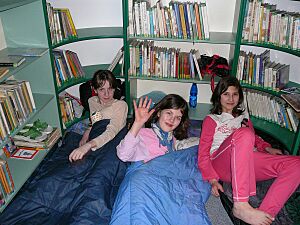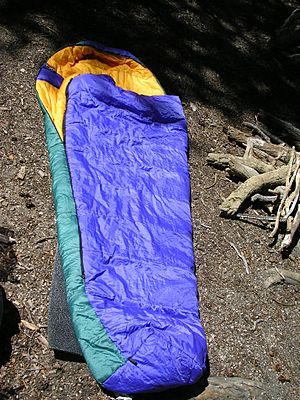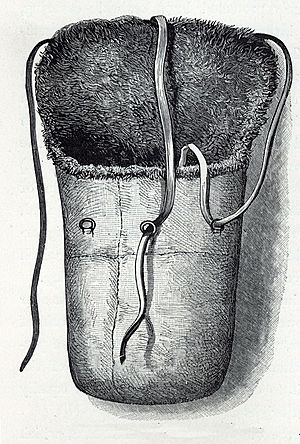Sleeping bag facts for kids
A sleeping bag is like a special blanket that keeps a person warm. It's designed to be light and easy to carry. You can zip it up to make a cozy tube. People use sleeping bags when they sleep outdoors, like when camping, hiking, or climbing. They are also great for sleepovers or when you need an extra bed indoors.
The main job of a sleeping bag is to keep you warm. It has special filling inside that traps heat. This filling can be synthetic (man-made) or natural, like down feathers. Sleeping bags also usually have a cover that can stop some wind chill and light rain. But for real protection from bad weather, people often use a tent too. The bottom of a sleeping bag offers a little cushion. However, a sleeping pad or a camp cot is often used underneath for more comfort. Sometimes, a plastic tarp is placed on the ground to keep moisture away.
There are many kinds of sleeping bags for different uses. Some are very light and thin, perfect for summer camping or indoor sleepovers. Others are thick and warm, made for cold weather. The best ones for serious hikers are light and super warm, but they cost more. A special type called a mummy bag has a hood to keep your head warm. A bivouac sack (or bivy) is a waterproof cover for a sleeping bag. It can be used instead of a tent by experienced hikers who want to travel light. Hikers might also carry a bivy bag for emergencies, in case they get lost or bad weather hits.
Contents
History of Sleeping Bags
The idea of a sleeping bag is quite old! One of the first designs was called the "Euklisia Rug." It was invented by Pryce Pryce-Jones in 1876. He was a Welsh businessman who sold his rugs all over the world. Records show he sold 60,000 of them to the Russian army. The British Army also bought them. People used them for many things, like missionaries in Africa and pioneers in Australia.
Types of Sleeping Bag Designs
A simple sleeping bag looks like a square blanket. It has a zipper on two or three sides. This lets you get inside and close it up. You can fold and roll this type of bag to pack it. This basic design works well for most camping trips. But it might not be enough for very cold or tough conditions.
Another main type is called a mummy bag. It's shaped differently. It gets narrower from the head to the feet. This shape helps it hold heat better because there's less space inside. Some mummy bags are even made to fit women's body shapes. Most mummy bags don't unzip all the way to the feet. This is because zippers can let warm air escape. The tapered shape and shorter zipper help keep your feet warm. Your feet can lose heat faster than other body parts. Mummy bags also have a drawstring at the head. This helps to seal in warm air. Mummy bags are usually just stuffed into a stuff sack or compression sack, not neatly rolled.
The bottom of a sleeping bag doesn't keep you very warm. This is because your body weight squishes the insulation. So, it's important to use a sleeping pad underneath you, especially in cold weather. Some sleeping bags don't even have insulation on the bottom. Some have a special pocket to hold a sleeping pad. Some campers, especially those who want to carry very little, use something called a "top quilt." This is like a sleeping bag without a back.
What's Inside: Sleeping Bag Fillings
Sleeping bags use different materials for insulation. Cheaper bags for warm weather often have synthetic (man-made) quilt insulation. People who camp or hike a lot usually choose between synthetic fill or natural down feathers. They often debate which one is better!
Synthetic fill doesn't soak up water easily. It dries fast and can still keep you somewhat warm even if it gets wet. This can be very important if your bag accidentally falls into water on a cold day. Synthetic material is also strong and keeps its shape. So, it insulates well even when you lie on it. However, synthetic bags are usually heavier and don't pack down as small. Also, synthetic insulation can wear out faster than natural down.
Down fill is lighter than synthetic and keeps you warmer. But it usually costs more money. Down must be kept dry. A wet down sleeping bag can make you colder than having no bag at all, which can lead to hypothermia. Newer, high-tech sleeping bags often have water-resistant outer layers. This means they can be used in damp conditions. It's a good idea to store your sleeping bag in a large storage sack when not using it. Don't keep it squished in its small travel bag for long periods. Many hikers agree that hanging your sleeping bag is the best way to store it. Just make sure to move its position on the hanger sometimes so the filling doesn't get squished in one spot.
Other materials like cotton and wool have also been used. Wool can repel water and resists squishing. But it's much heavier than other options. Cotton soaks up a lot of water and is heavy. But it's cheap, so it's good for car camping where weight isn't a big problem. Cotton insulation won't keep you warm if it gets wet. So, serious hikers don't use cotton-filled sleeping bags.
Understanding Temperature Ratings
In Europe, there's a special rule called the EN 13537 standard (now ISO 23537-1:2016). This rule helps people know how warm a sleeping bag will be. A test uses a heated mannequin (a dummy) to figure out four temperatures:
- The upper limit is the warmest temperature where a 'standard' adult man can sleep comfortably without sweating too much.
- The comfort rating is based on a 'standard' adult woman having a comfortable night's sleep.
- The lower limit is the coldest temperature where a 'standard' adult man can sleep comfortably.
- The extreme rating is only for survival. It's the lowest temperature a 'standard' adult man might survive in the bag. You should not rely on this rating for regular use.
The "transition zone" between the comfort and lower temperature is usually the best guide when buying a bag.
A sleeping bag's rating usually tells you the lowest temperature it will keep an average person warm. For example, a 0 °C (32 °F) bag means you should be able to sleep in 0 °C weather. But it doesn't mean you'll be super cozy.

In the U.S., there isn't one standard way to measure warmth. So, a 20 °F (-7 °C) bag from one company might not be as warm as a 20 °F (-7 °C) bag from another. Other things also affect how warm you stay. These include what you wear to sleep, what kind of sleeping pad you use, and how well your body naturally holds heat.
It's important to know that moisture, either from outside or from sweating, makes sleeping bags much less warm.
Sleeping Bags for Indoors
Indoor sleeping bags are sometimes called slumber bags. They are very common, especially for children. These bags are usually not made to handle outdoor weather. They are often made of natural fabrics instead of the synthetic ones used for outdoor bags. Children's slumber bags often have fun, colorful designs, like pictures of cartoon characters. Slumber bags make sleeping on the floor more comfortable. They are often used for sleepovers, family visits, or when there aren't enough beds for everyone.
The Icehotel in Jukkasjärvi, Sweden, gives guests special sleeping bags. These bags are tested for polar conditions. Guests use them when sleeping on beds made of ice, covered with reindeer furs.
Sleeping Bags for Babies
An infant sleeping bag is like a special piece of clothing or a cover for babies to sleep in. Baby sleeping bags are different from regular ones. They are mostly for indoor use, not for camping. They usually have arm holes or sleeves.
You can find baby sleeping bags for winter and summer. Some brands even make them for all seasons.
In the UK, the safety standard for children's sleep bags says they are for children weighing at least 4 kg (8.8 lb). They are designed to keep the baby warm enough without needing extra blankets in a cot. This standard does not include "sleep suits" (like pajamas with feet) or products made for outdoor use.
See also
 In Spanish: Saco de dormir para niños
In Spanish: Saco de dormir para niños
- Bivouac sack
- Cowboy bedroll
- Mosquito net
- Pertex
- Sleeping bag liner
- Swaddling








